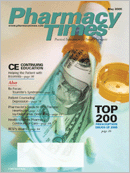Publication
Article
Pharmacy Times
CASE STUDIES
Author(s):
CASEONE:DK, a 70-year-old woman, isadmitted to the hospital for anelective vaginal hysterectomywith abdominal repair. She hasa long history of pelvic prolapse.During the past year,this condition has led to difficultyurinating, requiring selfcatheterization.
DK's medical history is significantfor obesity, hypertension, and hyperlipidemia. A cardiaccatheterization shows that she has 3-vessel coronaryartery disease. She suffers from occasional chest tightnessand pain, during exercise and at rest, which respond to sublingualnitroglycerin.
While DK is recovering in the postanesthesia care unitfollowing her procedure, the surgical resident asks theintern to begin writing orders for DK's transfer to the surgicalfloor. As the resident walks away, he reminds the internto order appropriate measures to prevent a postoperativevenous thromboembolism. The intern is unsure about what theresident means by "appropriate measures," so he asks thepharmacy student to assist him.
The pharmacy student explains that a low-risk patient cansimply receive early ambulation, whereas a moderate-riskpatient requires low-dose, unfractionated heparin (LDUFH),low-molecular-weight heparin (LMWH), intermittent pneumaticcompression (IPC), or elastic compression stockings. Heexplains that a high-risk patient should receive LDUFH, LMWH,or IPC. A very high-risk patient should receive IPC plus LDUFHor LMWH or warfarin.
What risk factors does DK have for developing a thromboembolism?What should the pharmacy student recommendto prevent a clot?
CASE TWO:While working at Sunny ViewPharmacy, which is locatednear a busy marina, the pharmacistis approached by a manwho is carrying a small box. Theman explains that he is in townwith his friends for a deep-sea-fishingvacation. Because heknew that he was prone to motion sickness, he purchased aprescription transdermal scopolamine patch before leavinghome. He says that the patch was completely ineffective theprevious day, causing him to vomit repeatedly over the side ofthe boat. Since he will be heading back out on the boat today,he wants to know what the pharmacist recommends.
The pharmacist asks the man how he used the patch. Theman rolls up his sleeve to expose a small tan-colored patch.He says that he put the patch on his arm as soon as heboarded the boat yesterday. His doctor had told him that thepatch was good for 3 days, but he was considering taking itoff because it was not helping.
What recommendations can the pharmacist make toimprove the man's use of the scopolamine patch?
Dr. Schlesselman is an assistant clinical professor at the University of Connecticut School of Pharmacy.
Click Here For The Answer ----------->
[-]
CASE ONE: DK's risk factors include obesity, age over 40 years, and major surgery. These risk factors put her at high risk. Becauseshe is a high-risk patient, preventive measures should include low-dose unfractionated heparin or low-molecular-weight heparin. Unfractionated heparinis less expensive and as effective as low-molecular-weight heparin.
CASETWO: Scopolamine, derived from an alkaloid of belladonna, works by depressing the action of the nerve fibers near the ear and the vomiting centerof the brain and central nervous system. For maximum effect, the patch should be applied on the hairless area behind the ear at least 4 hours prior toboarding the boat.
toggle(getObject('exp1048685570_link'), 'exp1048685570');







